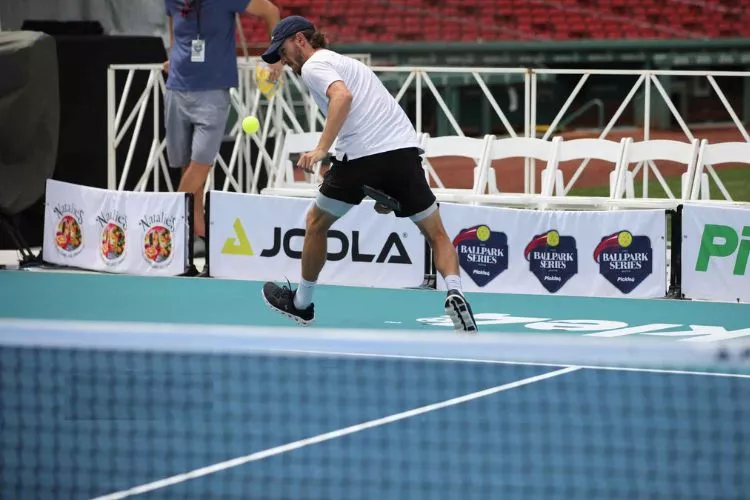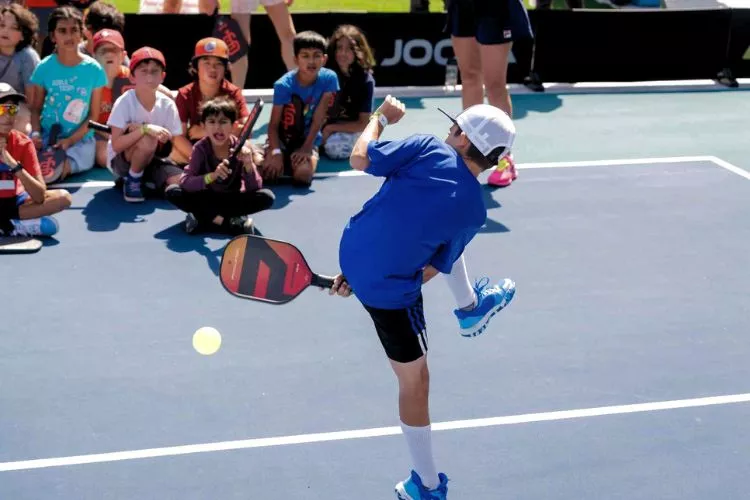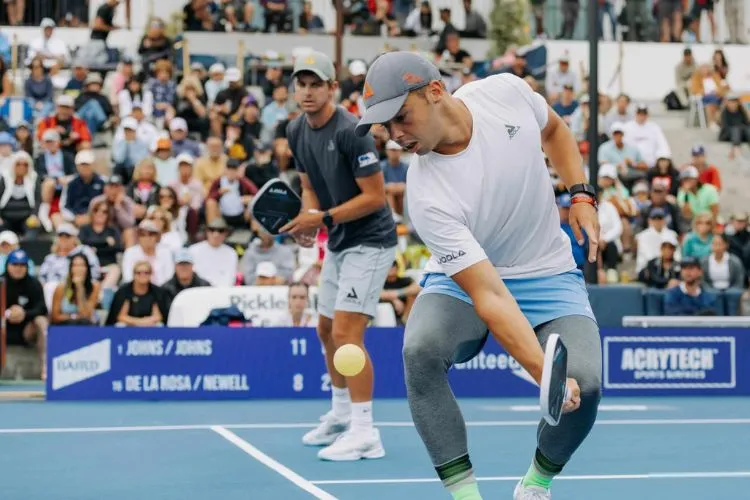Pickleball, a rapidly-growing sport that combines elements of tennis, badminton, and table tennis, has become widely popular for its accessible gameplay and exciting challenges.
Amidst many strategic shots in this exhilarating game lies the intriguing and elusive “tweener in pickleball.”

Interested players and pickleball enthusiasts alike will uncover the essential skills and techniques behind the “tweener,” a shot that can both dazzle opponents and amp up your game. So grab your paddles, and let’s dive right in!
What is the tweener in pickleball?
A “tweener” is a shot in pickleball. It’s not common. Players use it in special cases. You hit a tweener between your legs.
It happens when a ball goes past you towards the baseline.
You hit the ball towards the net while facing away from it. A tweener is not easy to make. But it stuns your opponent when done perfectly. It’s a fun shot to try.
Ring pros or casual players do not rely on tweeners in a serious match. There’s too much risk. You might fail and lose a point. Yet, it adds flair to your game.
Practice helps to make it work. But remember, a tweener is just a part of a big game. Main skills are still the key to winning.
Strategy beats stunts every time. Pickleball is about power, precision, and placing the ball just right. To sum it up, a tweener is a tricky shot in pickleball.
You hit the ball behind you, between your legs. It’s a showy move that adds surprise. It’s not a main strategy. It’s an extra skill to spice up your game.
Practicing the Tweener: Essential Techniques
Mastering the tweener shot in pickleball requires dedication, practice, and an understanding of the various elements involved.
In this section, we will explore essential techniques to improve your tweener skills, from practicing proper footwork to optimizing paddle positioning.
With a clear pathway to success, you’ll be able to add flair and unpredictability to your pickleball game.

Building the Foundation: Footwork
Before attempting the tweener shot, it’s crucial to build a solid foundation with proper footwork. Footwork plays a significant role in maintaining balance, positioning yourself for the shot, and maneuvering quickly in response to the ball’s direction.
Key Footwork Tips:
- Maintain a low center of gravity: Bend your knees slightly and position your feet shoulder-width apart to achieve better balance and stability.
- Stay on the balls of your feet: This allows for quicker movement and better agility while preparing to execute the tweener shot.
- React quickly: Identify when the tweener opportunity arises and swiftly position yourself accordingly to reach the ball as it passes you.
Mastering these footwork basics will significantly improve your capacity to execute the tweener shot successfully.
Paddle Positioning and Control
Proper paddle positioning is another vital part of perfecting the tweener shot. Knowing how to hold and swing the paddle is essential to achieving optimal control, spin, and power when striking the ball.
Important Paddle Tips:
- Grip type: Use the Continental or Eastern grip for the tweener shot, as it allows for better wrist flexibility and easier stroke execution.
- Paddle face angle: Adjust your paddle’s angle when making contact with the ball to control the shot’s direction and apply different spins.
- Wrist action: Employ a combination of wrist snap and forearm follow-through to generate power and manipulate the ball’s trajectory.
Implementing these paddle handling techniques can dramatically enhance your tweener shot’s precision and effectiveness.
Drill Progressions: Practice Makes Perfect
As the saying goes, practice makes perfect. Here are some drill progressions you can use to practice and improve your tweener shot:
Partner Drills:
- Stationary Tweener: Stand at the baseline with a partner on the opposite side of the court. Have your partner toss balls over the net, aiming to land them directly behind you. Practice executing the tweener shot as the ball goes past you.
- Moving Tweener: Begin a few steps behind the baseline and have your partner toss balls over the net in various directions. Move towards each shot, adjusting your footwork and positioning to execute the tweener effectively.
Solo Drills:
- Wall Practice: Find a solid wall with enough space. Stand approximately 10-15 feet away and hit the ball against the wall. As the ball bounces back at a low trajectory, practice hitting the tweener as it passes you.
- Self-Feed Tweener: Toss the ball onto the court yourself and allow it to bounce before executing a tweener shot. This method can help you adjust and perfect your footwork, positioning, and timing.
By incorporating these drill progressions into your practice routine and focusing on continual improvement, you’ll build the consistency and skill required to execute the tweener shot confidently.
The Mental Game: Patience and Trust
A significant factor in perfecting the tweener shot is cultivating the right mental attitude. Developing patience, trust in your abilities, and the willingness to fail before finding success is essential to acing this challenging technique.
Mental Strategies:
- Embrace failure: Accept that you will miss shots and make mistakes during your practice, but remember that each failure leads to valuable learning experiences.
- Visualize success: Imagine yourself executing the tweener shot with precision and power during games or practice sessions. Visualization helps build self-confidence and a belief in your abilities.
- Stay encouraged: Be your own cheerleader and acknowledge your progress, even in small increments. Celebrate your improvements and maintain a positive attitude throughout the learning process.
By adopting these mental strategies and combining them with proper footwork, paddle control, and consistent practice, you’ll be well on your way to adding the tweener shot to your pickleball repertoire.
With patience, effort, and determination, this impressive move can become an accessible and exciting part of your game.
Breaking Down the Tweener: When to Use it
The tweener shot is special in pickleball. Players don’t use it often. Only a few cases need it. A tweener is a fancy shot. You use it for surprise.

Let’s understand when to use it.
- Against a Lob: Your opponent can send a high lob. You might miss the chance to smash it back. The ball goes past you. It nears the baseline. A tweener can save you here.
- On the Defensive: You play on the defensive side. Your rivals fire fast shots at you. The ball gets past you. The tweener can work here.
- For Surprise: A tweener is startling. It’s unexpected. It can stun your opponent. They won’t see it coming.
- For Fun: Pickleball is about fun too. A tweener shot can bring laughs. It boosts the spirit of the game.
In short, use the tweener when you’re on the edge. It is also for fun times. It’s not a go-to move. It’s a surprise card. It’s to stun and entertain. But remember, pickleball isn’t about risky shots.
The focus is on control. It’s about good defense and strong serves. Use regular strokes most times. Keep the tweener for the right moments.
Conclusion:
The “tweener” is an unique and entertaining shot in the diverse world of pickleball. Though it’s not a common or easy-to-execute shot, it possesses its own charm, bringing an element of surprise and fun to the game.
Its strategic usage varies from countering a high lob or playing a defensive shot to simply surprising your opponents and elevating the joy of the game.
However, the tweener shot requires balanced footwork, proper paddle control, and consistent practice to master.
Remember, this shot is not a cornerstone strategy but a spicy addition to your repertoire. Your overall skills and tactical gameplay are what truly determines your success in pickleball.
Hence, while you engage in practicing and honing the tweener shot, never lose sight of developing your core skills in pickleball.

Pickleball’s more than a game to me—it’s a passion. I write, sharing its highs and lows, the thrills and the lessons. Some tales might draw you to the court, while others give a hint of the game’s magic. So, curious about my journey? Ready to dive deep into the world of pickleball with me? Let’s go.
